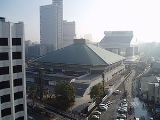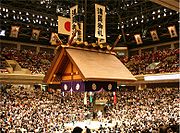
Ryogoku Kokugikan
Encyclopedia
, also known as Sumo Hall, is an indoor sporting arena located in the Ryōgoku
neighborhood of Sumida
, one of the 23 wards of Tokyo
in Japan
, next to the Edo-Tokyo Museum
. It is the third building built in Tokyo associated with the name kokugikan. The current building was opened in 1985 and has a capacity of 13,000 people. It is mainly used for sumo wrestling
tournaments (honbasho
) and hosts the hatsu (new year) basho in January, the natsu (summer) basho in May, and the aki (autumn) basho in September. It also houses a museum about sumo. The venue is also used for other indoor events, such as boxing, pro wrestling, and music concerts. In past years, it has hosted the G-1 Climax, an annual tournament in New Japan Pro Wrestling
.
, and some tournaments were held outdoor at a baseball stadium. During the occupation of Japan, SCAP
saw sumo as less threatening than other martial arts, and allowed a tournament there in November 1945. The occupation forces subsequently took over the area, however, and turned it partially into a skating rink. One more tournament was held in November 1946, but tournaments were thereafter held on the grounds of the Meiji Shrine
until 1954. Tournaments were subsequently held in the Kuramae Kokugikan
, which opened in 1954, until it was replaced by the current Ryōgoku Kokugikan in 1985.

35°41′49"N 139°47′36"E
Ryogoku
is a neighborhood in Sumida, Tokyo. It is surrounded by various neighborhoods in Sumida, Chūō, and Taitō wards: Yokoami, Midori, Chitose, Higashi Nihonbashi, and Yanagibashi....
neighborhood of Sumida
Sumida, Tokyo
is one of the 23 special wards of Tokyo, Japan. It calls itself Sumida City in English.As of 2008, the ward has an estimated population of 240,296 and a density of 17,480 persons per km²...
, one of the 23 wards of Tokyo
Tokyo
, ; officially , is one of the 47 prefectures of Japan. Tokyo is the capital of Japan, the center of the Greater Tokyo Area, and the largest metropolitan area of Japan. It is the seat of the Japanese government and the Imperial Palace, and the home of the Japanese Imperial Family...
in Japan
Japan
Japan is an island nation in East Asia. Located in the Pacific Ocean, it lies to the east of the Sea of Japan, China, North Korea, South Korea and Russia, stretching from the Sea of Okhotsk in the north to the East China Sea and Taiwan in the south...
, next to the Edo-Tokyo Museum
Edo-Tokyo Museum
The is a museum of the history of Tokyo, established in 1993. The main features of the permanent exhibitions are the life-size replica of the Nihonbashi, which was the bridge leading into Edo; the Nakamuraza theatre; scale models of town; and buildings from the Edo, Meiji and Shōwa periods.The...
. It is the third building built in Tokyo associated with the name kokugikan. The current building was opened in 1985 and has a capacity of 13,000 people. It is mainly used for sumo wrestling
Sumo
is a competitive full-contact sport where a wrestler attempts to force another wrestler out of a circular ring or to touch the ground with anything other than the soles of the feet. The sport originated in Japan, the only country where it is practiced professionally...
tournaments (honbasho
Honbasho
A is an official professional sumo tournament. There are six held each year, a system established in 1958. Only honbasho results matter in determining promotion and relegation for rikishi ....
) and hosts the hatsu (new year) basho in January, the natsu (summer) basho in May, and the aki (autumn) basho in September. It also houses a museum about sumo. The venue is also used for other indoor events, such as boxing, pro wrestling, and music concerts. In past years, it has hosted the G-1 Climax, an annual tournament in New Japan Pro Wrestling
New Japan Pro Wrestling
is a major professional wrestling promotion in Japan, founded by Antonio Inoki in June 1972 and owned by Yuke's since 2005, when Inoki sold the promotion. Naoki Sugabayashi is the current President of the promotion and has held that position from 2007. Owing to its TV program aired on TV Asahi, it...
.
History
The growing popularity of Sumo during the Meiji period led to the building of the original Kokugikan in Ryōgoku in 1909. The Japanese army appropriated the facility in the World War IIWorld War II
World War II, or the Second World War , was a global conflict lasting from 1939 to 1945, involving most of the world's nations—including all of the great powers—eventually forming two opposing military alliances: the Allies and the Axis...
, and some tournaments were held outdoor at a baseball stadium. During the occupation of Japan, SCAP
Supreme Commander of the Allied Powers
Supreme Commander of the Allied Powers was the title held by General Douglas MacArthur during the Occupation of Japan following World War II...
saw sumo as less threatening than other martial arts, and allowed a tournament there in November 1945. The occupation forces subsequently took over the area, however, and turned it partially into a skating rink. One more tournament was held in November 1946, but tournaments were thereafter held on the grounds of the Meiji Shrine
Meiji Shrine
', located in Shibuya, Tokyo, is the Shinto shrine that is dedicated to the deified spirits of Emperor Meiji and his wife, Empress Shōken.-History:...
until 1954. Tournaments were subsequently held in the Kuramae Kokugikan
Kuramae Kokugikan
was a building situated in the Kuramae district of Tokyo which was built by the Japan Sumo Association and opened in 1950. The Association needed a permanent venue to hold sumo tournaments as the previous, bomb-damaged, Kokugikan had been taken over by occupying Allied forces after World War II...
, which opened in 1954, until it was replaced by the current Ryōgoku Kokugikan in 1985.

In Other Media
In the anime series Hajime no Ippo, some of the characters participate in boxing matches in Ryōgoku Kokugikan.External links
35°41′49"N 139°47′36"E

